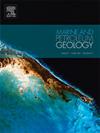Inconsistencies in organosulfur compounds during natural and artificial maturation
IF 3.6
2区 地球科学
Q1 GEOSCIENCES, MULTIDISCIPLINARY
引用次数: 0
Abstract
Hydrous pyrolysis techniques are valuable for understanding and quantifying petroleum yield, thermal maturity, compositional variations, and kinetics across different kerogen types. Such data is essential for basin modeling and well planning. Previous studies have shown that sulfur-rich Type II-S kerogen generates hydrocarbons at lower temperatures due to its lower activation energy, resulting in early cracking. Consequently, organosulfur presents a challenge in numerous basins worldwide, as sulfur-rich source rocks from various regions must be examined closely to accurately predict hydrocarbon generation in each basin. Additional factors, such as total organic carbon content and mineralogy, also influence the timing and yield of oil generation. Methyldibenzothiophene isomers have proven to be reliable maturity indicators in sulfur-rich source rocks, often providing more accurate maturity predictions than biomarkers at higher maturity levels. However, few studies have closely examined the compositional and isomeric changes of alkylated methyldibenzothiophene compounds under hydrous pyrolysis conditions. In this study, hydrous pyrolysis experiments were conducted on three sulfur-rich source rocks and one sulfur-rich crude oil at temperatures between 275 and 360 °C to monitor and quantify changes in alkylated MDBT compounds as well as other aromatic hydrocarbons. The results were compared to four naturally matured Type II-S source rocks, spanning the immature to condensate windows, to evaluate the effects of hydrous pyrolysis on aromatic compounds. Significant differences in thermal maturity parameters were observed in the kerogen, bitumen, and expelled oil. While the increase in the 4-MDBT/1-MDBT ('MDR') ratio provided consistent thermal maturity estimates in natural samples, the hydrous pyrolysis experiments revealed that these geochemical markers are inconsistent under artificial thermal conditions, potentially due to additional sulfur species forming in the reactor, buffering reactions in the closed system reactor, the limited temperature range of the experiments, or other matrix-controlled interactions that are found in nature but are not occurring in the reactor. In contrast, aromatic biomarkers such as triaromatic steroids showed a positive increase in their isomer ratios relative to the experimental run temperature. The chemical differences between these organosulfur-rich samples (e.g., TOC, hydrogen index, mineralogy) suggest that the original source material—not solely the sulfur content—plays a critical role in the kinetics of alkylated dibenzothiophene compounds.
有机硫化合物在自然和人工成熟过程中的不一致性
含水热解技术对于理解和量化不同干酪根类型的石油产量、热成熟度、成分变化和动力学具有重要意义。这些数据对于盆地建模和井规划至关重要。前人研究表明,富硫II-S型干酪根由于活化能较低,在较低温度下生成烃,导致早期裂解。因此,有机硫在世界范围内的许多盆地中都是一个挑战,因为必须仔细检查来自不同地区的富硫烃源岩,才能准确预测每个盆地的生烃情况。其他因素,如总有机碳含量和矿物学,也会影响生油的时间和产量。甲基二苯并噻吩异构体已被证明是富硫烃源岩的可靠成熟度指标,通常比高成熟度水平的生物标志物提供更准确的成熟度预测。然而,很少有研究仔细研究烷基化甲基二苯并噻吩化合物在加水热解条件下的组成和异构体变化。本研究对3种富硫烃源岩和1种富硫原油在275 ~ 360℃的温度下进行了加水热解实验,以监测和量化烷基化MDBT化合物以及其他芳香烃的变化。研究结果与4种自然成熟II-S型烃源岩进行了对比,跨越了未成熟到凝析油窗口,以评价加氢热解对芳烃化合物的影响。干酪根、沥青和排油的热成熟度参数存在显著差异。虽然4-MDBT/1-MDBT ('MDR')比值的增加为自然样品提供了一致的热成熟度估计,但含水热解实验表明,这些地球化学标志在人工热条件下不一致,可能是由于反应器中形成了额外的硫种,封闭系统反应器中的缓冲反应,实验温度范围有限。或者其他在自然界中发现但不在反应器中发生的基质控制的相互作用。相比之下,芳香族生物标志物,如三芳香族类固醇,其异构体比例相对于实验运行温度呈正增加。这些富硫有机样品之间的化学差异(如TOC、氢指数、矿物学)表明,原始原料——而不仅仅是硫含量——在烷基化二苯并噻吩化合物的动力学中起着关键作用。
本文章由计算机程序翻译,如有差异,请以英文原文为准。
求助全文
约1分钟内获得全文
求助全文
来源期刊

Marine and Petroleum Geology
地学-地球科学综合
CiteScore
8.80
自引率
14.30%
发文量
475
审稿时长
63 days
期刊介绍:
Marine and Petroleum Geology is the pre-eminent international forum for the exchange of multidisciplinary concepts, interpretations and techniques for all concerned with marine and petroleum geology in industry, government and academia. Rapid bimonthly publication allows early communications of papers or short communications to the geoscience community.
Marine and Petroleum Geology is essential reading for geologists, geophysicists and explorationists in industry, government and academia working in the following areas: marine geology; basin analysis and evaluation; organic geochemistry; reserve/resource estimation; seismic stratigraphy; thermal models of basic evolution; sedimentary geology; continental margins; geophysical interpretation; structural geology/tectonics; formation evaluation techniques; well logging.
 求助内容:
求助内容: 应助结果提醒方式:
应助结果提醒方式:


